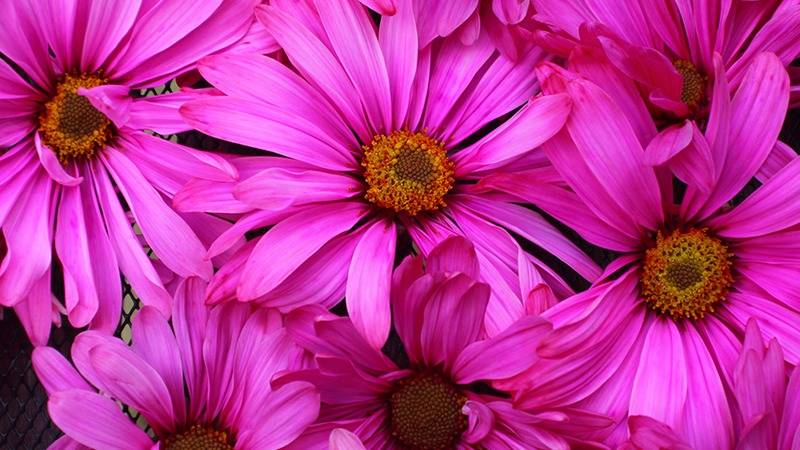Growing media for Mums and Perennials


We often receive questions as to which PRO-MIX® growing media is best suited for mums, perennials and small nursery containers. In this article, we will review the various PRO-MIX products offered for these specific crops and explain their intended uses.
Several PRO-MIX blends are suitable for these applications, including peat/bark blends and peat/chunk coir blends (Table 1). All PRO-MIX products contain a wetting agent to facilitate water absorption and distribution, limestone for pH adjustment and a starter nutrient charge to help plants acclimate after potting. Peat/bark blends are heavier-weight products and provide low water retention compared to peat/chunk coir blends which are lighter-weight products and have high water retention (Table 2).
For these products, we offer the choice of adding mycorrhizae, which are natural, beneficial fungi that assist plants in the acquisition of water and some nutrients mycorrhizae, or AGTIV® REACH™ produce more vigorous plants with more prolific flowering. We also offer Bacillus, which is a natural bacterium that suppresses certain root pathogens, including Alternaria, Fusarium, Pythium and Rhizoctonia (Table 1).
|
PRO-MIX PRODUCTS |
Canadian Sphagnum Peat Moss |
Coir Chunk |
Processed Pine Bark |
Perlite – Coarse |
Starter Nutrients |
pH Adjusted |
Wetting Agent |
Bacillus + Mycorrhizae |
Mycorrhizae |
|
PRO-MIX BKI |
40-50 |
- |
35-45 |
10-20 |
X |
X |
X |
O* |
O |
|
PRO-MIX BK |
60-70 |
- |
15-25 |
10-20 |
X |
X |
X |
O |
O |
|
PRO-MIX BKH |
25-35 |
- |
55 |
- |
X |
X |
X |
|
O |
|
PRO-MIX HPCC |
65-75 |
20-30 |
- |
5-10 |
X |
X |
X |
O |
O |
|
PRO-MIX PRODUCTS |
pH Range * |
EC (mmhos/cm) * |
Air Porosity (by Vol.) ** |
Bulk Density (lb/ft³) |
Plant Available Water |
|
PRO-MIX BKI |
5.2 - 6.2 |
1.5 - 2.5 |
11 – 17 % |
14 - 19 |
Low |
|
PRO-MIX BK |
5.2 - 6.2 |
1.5 - 2.5 |
12 – 18 % |
11 - 15 |
Moderate |
|
PRO-MIX BKH |
5.2 - 6.2 |
1.5 - 2.5 |
20 – 25 % |
18 – 20 |
Very Low |
|
PRO-MIX HPCC |
5.2 - 6.2 |
1.0 - 2.0 |
14 – 20 % |
8 - 10 |
High |
Bark-Based Growing Media
PRO-MIX® BK and PRO-MIX® BKI are Canadian-made growing media with processed pine bark. The bark comes from red pine trees and is partially composted, aged and screened to ½” particle size. PRO-MIX® BKH is made in our Virginia facility and are available in the eastern and midwestern US. Pine bark used for these products is also partially composted, aged and screened to ½” (PRO-MIX BK) or ¾” particle size (PRO-MIX BKH). All bark sources are nitrogen stabilized with a carbon-to-nitrogen ratio of 35:1 (C:N). This is important since a higher C:N ratio can result in nitrogen drawdown during the crop cycle, so higher application rates of nitrogen would be required so that plants would not be deprived. However, this is not the case for these products.
Coir Chunk Growing Media
PRO-MIX® HPCC product is made with peat, coir chunks and perlite. Coir chunks are pieces of the coconut husk that have been cut to a particle size of 7-9 mm. What is unique about coir chunks is that they hold much more plant assessable water than bark, while providing extra air porosity and structure for the growing medium. For bark, most of the plant-accessible water is found on its surface, while water found within a bark particle is inaccessible to plants, therefore bark has a low water-holding capacity. Bark particles also contribute to air porosity and structure, as long as they are not less than <1/8”. Note in Table 2 that the air porosity of coir chunk products is similar to bark media.
What influences the choice of growing media for mums and perennials production?
When selecting these products for mums, perennials and small nursery containers, there are several factors to take into consideration:
- Container size
- Crop time/duration
- Growing environment
- Type of crop
Container Size
Let’s take a fall garden mum crop for example. Choosing a shallow 10” diameter mum pan (8” tall) or a deep 10” diameter nursery container (12” tall) influences the water-holding capacity of the selected growing medium. Even though the containers are the same diameter, the height of the container and container volume will influence the water holding capacity. The height is a factor because there is a saturated layer of growing medium at the bottom of the container. If the growing medium is the same, the height of this layer is the same, regardless of the depth of the container. In the case of the shallow mum pan, a higher percentage of the growing medium is within the saturated zone, so the growing medium retains more water. In a tall nursery container, a smaller percentage of the growing medium is within this saturation zone (due to the effects of gravity). Therefore, taller containers dry out faster than shallow containers with the same diameter.
Crop Time / Growing Environment for mums and perennials
Now let’s consider the crop time/duration and growing environment for mum and perennial crops. Young rooted cuttings initially planted into large containers are easier to overwater since the growing medium dries out slowly. As the plant grows, it will use up water from the growing medium more rapidly, so irrigation needs to occur more frequently.
- If you are located in an area that has low relative humidity and high temperatures, mums and perennials will tend to dry out too quickly. For this application, PRO-MIX HPCC may be the best choice. If these crops are grown in an area that has a high relative humidity and high temperature, PRO-MIX BK or PRO-MIX BK would be the proper products to use.
- If a perennial crop is grown during the fall through spring in cool, wet conditions, then PRO-MIX BKH would be the best choice.
In any situation, attention must be given to irrigation frequency and volume of water. Too much water can reduce crop quality and increase root disease. Since these crops are typically grown outdoors, rainy, cloudy weather can impact the crop as well. Check moisture content by lifting several containers to check their weight or feeling the moisture of the growing medium in several containers.
Choosing the right growing medium for your type of crop
Perennials also have specific physical property requirements based on where they are native to. Most plants that have root systems with thick rhizomes (iris) or bulbs (anemone) use water slowly and prefer bark-based growing media that dry out rapidly (PRO-MIX BK, PRO-MIX BKI or PRO-MIX BKH).
Most perennials have fibrous roots and those such as agastache, columbine, coreopsis, dianthus, gaillardia, lavender, sedum, veronica, etc., prefer a bark-based growing medium that dries out rapidly, such as PRO-MIX BKI or PRO-MIX BKH.
Other perennials with fibrous roots such as daylily, echinacea, heuchera, hosta, leucanthemum, nepeta, phlox, salvia, etc. prefer a growing medium with higher water retention, such as coir chunk growing media (PRO-MIX HPCC) or a low percentage bark-based growing medium (PRO-MIX BK). For all of these blends, the addition of mycorrhizae favors the development of perennials and improves plant quality. Learn more about nursery crops and bark media and get tips for your chrysanthemum production.
PRO-MIX growing media offer flexibility for your mums and perennials. Depending on your environment, container size, crop type, etc., our bark or coir chunk-based growing media can offer you the physical properties you are looking for, along with PRO-MIX’s consistency and our high-quality active ingredients.
Learn more about our mixes for your perennials and mums here.